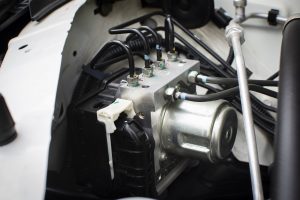With the hustle and bustle of our daily routines, it’s all too easy to let the nuances of traffic laws slip through the cracks of our memory. For those who are newly licensed or seasoned drivers, it’s imperative to remember that traffic laws are not static; they evolve to address the ever-changing landscape of road safety.
As your reliable roadside assistance partners at Agile Towing Company in Cary, NC, we’re here to offer a refresher on some crucial rules and regulations. We’ll delve into the intricacies of right of way, speed limits, signaling, and more, so keep reading to stay informed and safe on the road.
Right of Way
Starting with a fundamental concept – right of way – can sometimes lead to confusion on the road. Understanding right of way is crucial for traffic flow and safety. It dictates which vehicle is entitled to proceed first when paths cross.
Each state (and country for that matter) has it’s own set of laws governing this basic tenant of driving. In North Carolina, for example, there are several key right of way rules to follow: vehicles already in the intersection take precedence, at uncontrolled intersections without stop signs or signals, the vehicle to the right should be given the right of way, and, most critically, emergency vehicles with lights and sirens have the absolute right of way.
…For Pedestrians
Right of way rules become even more significant when it comes to the safety of pedestrians, who are among the most vulnerable users of the road. In Cary, NC, as in the rest of the state, motorists must always yield the right of way to pedestrians crossing the street in any marked crosswalk or at any unmarked intersection. This means that if a pedestrian is present or steps into a crosswalk, vehicles must stop and allow them to cross safely.
Pedestrians, however, also have a responsibility to adhere to traffic control signals and use crosswalks where available. Jaywalking, or crossing the street outside of a crosswalk, not only endangers the pedestrian but also disrupts the flow of traffic and can lead to dangerous situations for both drivers and pedestrians. It’s important for drivers to be especially vigilant in areas with high foot traffic, such as near schools, parks, and shopping centers, and in conditions of reduced visibility, whether due to weather, time of day, or obstructions.
Navigating Intersections in North Carolina
Navigating intersections with stop signs is a fundamental skill for drivers, but the rules can get a tad confusing when considering the number of different intersection configurations.
Here’s some of the most common scenarios…
4-Way Stop
In North Carolina, as in many places, the standard rule at a traditional four-way stop is that the first vehicle to come to a complete stop at the intersection has the right of way. If two vehicles arrive simultaneously, the driver on the left must yield to the driver on the right. This rule promotes a clear order of precedence, ensuring that all drivers have a fair opportunity to proceed.
2-Way Stop
When approaching a two-way stop where cross traffic does not stop, drivers must yield to vehicles that are already in the intersection or are approaching it so closely that they pose an immediate hazard. This is crucial in preventing collisions and ensuring that traffic on the through road can continue without unnecessary delays.
Uncontrolled Intersections
At intersections without stop signs or traffic signals (uncontrolled intersections), drivers must slow down and yield the right of way to any vehicle that has entered the intersection from another road. If the intersection is congested, drivers must yield to those coming from the right.
Roundabouts
Roundabouts present a different set of right of way rules and have gained popularity in Cary, NC, and many other regions for their ability to improve traffic flow and reduce the severity of accidents. At a roundabout, drivers approaching the circular intersection must yield to traffic already in the roundabout. Vehicles within the roundabout have the right of way since they are continuously moving. This means that incoming drivers must wait for a gap in the traffic before entering.
It’s important to note that within a roundabout, drivers should not stop or hesitate unnecessarily, as this can cause confusion and potential accidents. Instead, maintain a slow but steady pace, and signal before you exit the roundabout to inform other drivers of your intention to leave. Roundabouts often have multiple lanes, and the general rule is to stay in the right lane if you intend to exit at the first or second exit. If you plan to go straight or turn left, you may need to choose the left lane when entering the roundabout.
For pedestrian safety in roundabouts, crosswalks are typically set back from the circular roadway, allowing pedestrians to cross only the entering and exiting legs. Drivers must yield to pedestrians in these crosswalks, just as they would at any standard intersection.
Speed Limit Regulations
In North Carolina, speed limits are established to enhance safety and reduce the risk of accidents. The state has set maximum and minimum speed limits on highways to ensure a safe flow of traffic. On most interstate highways and controlled-access roads, the maximum speed limit is typically 70 mph, but it can be lower in certain areas due to road conditions, traffic patterns, or specific legislation. Drivers are expected to observe these limits closely and adjust their speed downward in response to adverse weather conditions, heavy traffic, or when driving through construction zones.
Outside of these highways, North Carolina has a general statutory speed limit. In cities and towns, unless otherwise posted, the speed limit is usually set at 35 mph. This default speed limit is in place to protect all road users in more densely populated and trafficked areas where pedestrians and cyclists are more common.
In addition to the general and highway-specific speed limits, North Carolina pays special attention to protected zones, particularly around schools. School zones are clearly marked with reduced speed limits to ensure the safety of children. These limits are typically 25 mph and are strictly enforced during school hours when children are arriving or departing. Flashing lights and signage are often used to alert drivers to the active lower speed limits. It is crucial for drivers to be extra vigilant and reduce speed accordingly in these areas, as children may be crossing the street or may not be easily visible.
Furthermore, fines for speeding in North Carolina can be significantly higher if you are caught speeding in a school zone or a work zone. These areas are considered to be of high risk for vulnerable individuals, and as such, the penalties are increased to deter reckless or dangerous driving behaviors. The presence of workers or children is a critical factor, and even if they are not immediately visible, drivers are expected to adhere to the posted limits.
For drivers in North Carolina, it is also important to remember that even if you are driving at the posted speed limit, you may still be required to slow down if the conditions dictate. For instance, if there is a heavy rainstorm, fog, or if you are driving on a road with sharp curves or steep descents, the safe driving speed may be well below the posted limit.
Adhering to these limits is not only a matter of legal compliance but also a commitment to the safety and well-being of our community. Safe driving practices help ensure that everyone, from the youngest schoolchildren to the workers improving our infrastructure, can go about their day without undue risk.
Check Out This Related Article…
Other Considerations
Signaling is an aspect of driving that should never be underestimated. A simple flick of the turn signal lever can communicate intentions to other drivers, facilitating smoother and safer lane changes, merges, and turns. It is recommended to signal at least 100 feet before making a turn or changing lanes, allowing ample time for other drivers to react. This not only prevents accidents but also serves as a legal protection, demonstrating that you’ve made a clear attempt to signal your intentions.
Diving into proper vehicle operation, the topic of mobile phone use while driving is paramount. North Carolina’s hands-free law stipulates that all cell phone use must be hands-free – this includes texting, browsing the internet, or making hand-held calls. Distractions, especially those involving technology, are a leading cause of road accidents. Eyes should always be on the road, and hands on the wheel.
For those visiting or new to North Carolina, be aware that driving regulations might differ from your home state. Ensure you’re familiar with local laws regarding license renewals, exams, and ID cards. Additionally, it’s crucial for all drivers to regularly check that their license and vehicle registration are current to avoid fines or penalties due to administrative oversights.
Wrapping Up
In closing, we at Agile Towing Company hope this article has served as a useful recap of some of the traffic rules that tend to be forgotten. Safe driving is a collective responsibility that demands awareness, preparation, and vigilance from everyone on the road. Should you ever need assistance or have questions about road safety, don’t hesitate to reach out to us.
Adhering to these guidelines is not only about following the law; it’s about protecting yourself and your fellow travelers. We all share the same goal – to arrive safely at our destinations.
Drive carefully and remember, call 919-276-5900 for fast roadside help if you need us on the roads of Cary, NC.



